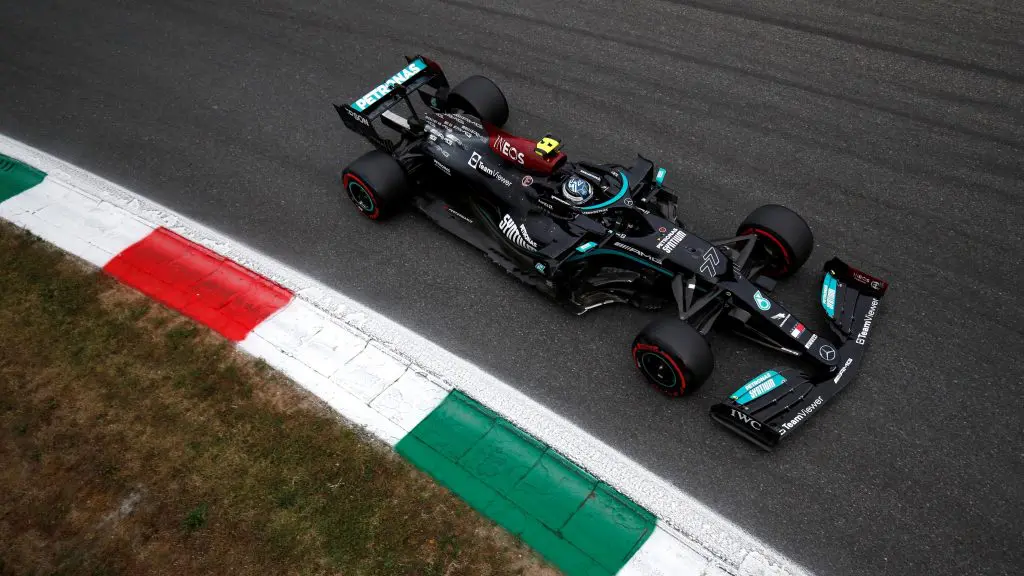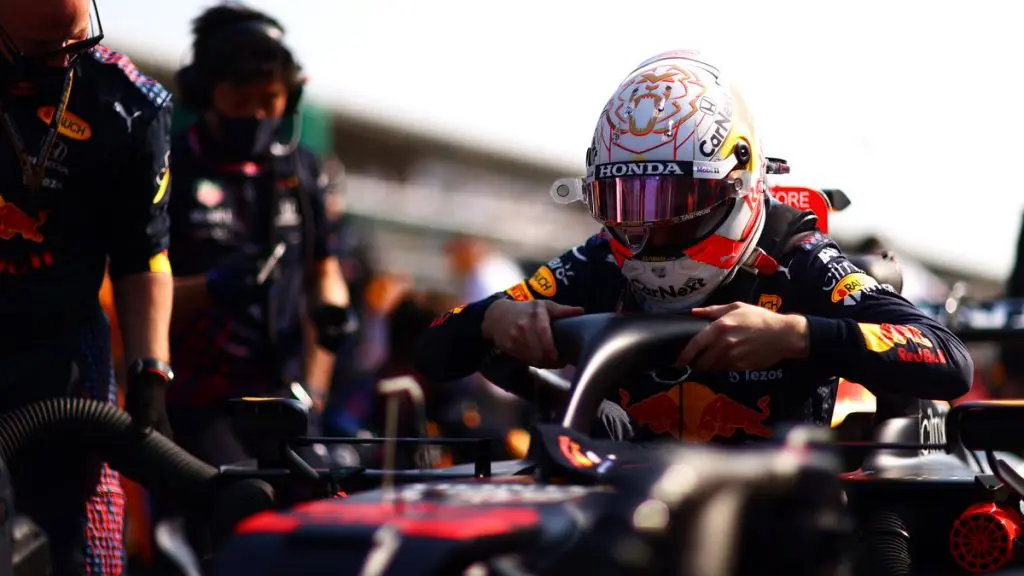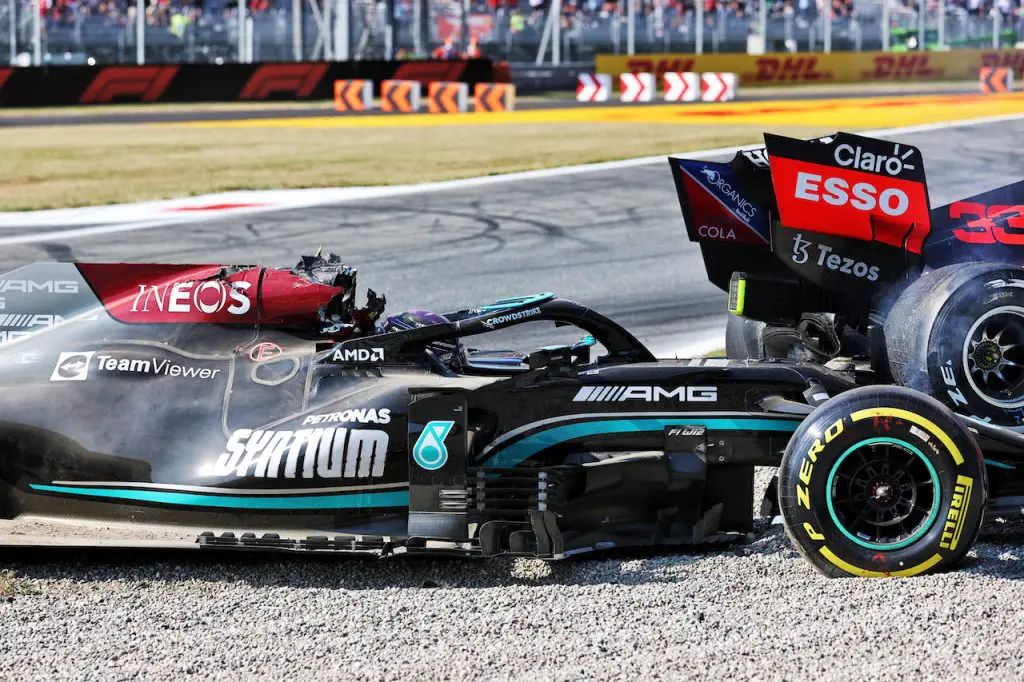Monza, the “Temple of Speed” and one of the oldest tracks on the F1 calendar. A circuit which provides thrilling races more often than not, and this year was no exception. The Italian Grand Prix sees teams bring one-off design solutions for a track which poses completely unique problems. With only eleven corners and two hard braking zones, Monza sees the highest speeds of the season (a possible exception being Mexico) and certainly some of the most challenging braking events.
Braking is difficult here not only due to the extraordinarily high speed, but also because the cars are run in absolute minimum downforce configuration, limiting the maximum amount of braking torque that can be applied without locking the front axle. Thermal management of the brakes is also especially difficult because the very long straights provide ample time and airflow to cool the brakes below their optimal temperature. As a result, practice time is critical for teams to decide how much blanking to apply to the brake ducts.
The aerodynamic tow (i.e. slipstream) is arguably more important at Monza than at any other circuit, with teams being unwilling to attempt a qualifying lap without one, to the point that several cars famously failed to make it over the line before the chequered flag in 2019. The extreme high speeds (+340kph) and long, straight sections of track mean that the tow can be important from very far behind (as much as 5 seconds), much more so than might otherwise be expected.
The reasons for this are intriguing. Not only does the leading F1 car create a pressure field around itself which can directly reduce the drag of the car behind, but it also creates a region of moving air in it’s wake that the trailing car drives into.

This reduced the relative velocity between the second car and the air, also reduces drag independently of the low pressure region of the car in front. The pressure field may equalize quite rapidly, but the velocity field lingers for considerably longer in proportion to the speed attained. This is why teams regularly send out cars out two at a time, to take maximum advantage of the aerodynamic tow from the car in front.
This F1 weekend saw the second attempt at the experimental Sprint Qualifying format which was introduced for the first time this year. This moves traditional qualifying to Friday after a one-hour Fp1 session in the morning. A second free practice session is held on Saturday, followed by a 100km Sprint Qualifying race which sets the grid for the Grand Prix on Sunday. Given the short amount of time to prepare the car setup for the sprint, all teams were on track immediately in Fp1 gathering data on tyre grip levels and degradation, cooling requirements, and aerodynamic performance.
Most teams brought custom rear wings for Monza, with McLaren running flow-viz paint on their bespoke rear wing looking for flow separation. Red Bull once again brought their “spoon” rear wing design in ultra-low downforce specification. Haas revealed a very interesting low-drag rear wing that had “breaks” in the trailing edge, presumably to further reduce drag. A similar concept was seen in the low-drag front wing Aston Martin brought to Spa.
It’s notable to call attention to the fact that Alpine F1 has had recurring problems with their exhausts, several of which have failed due to cracking or were replaced before they could fail. Alonso is currently on his 8th exhaust and Ocon is on his 7th. Grid penalties will be applied if 9 or more exhausts are required over the course of the season.

Early during Friday qualifying, we were informed that Valtteri Bottas would be taking an engine penalty and would be starting the race from the back of the grid. This was somewhat ironic, because the Finn summarily went on to storm to (not) pole position in Friday qualifying, nearly a tenth ahead of his seven-time world champion teammate Lewis Hamilton. Verstappen followed with the two McLarens were close behind, underlying their impressive pace that would become important later in the weekend.
Gasly followed in the Alpha Tauri, ahead of the two Ferraris. Perez was slightly off the pace in 9th, through Giovinazzi had an excellent showing in 10th.Free practice two was a particularly nondescript session, with FIA president Jean Todt later commenting that he did not understand the value of the session in terms of fan enjoyment or in gathering data.
For the Sprint Qualifying race, Hamilton got a poor start and dropped back down the grid, ultimately unable to pass Norris and finishing 5th. Pierre Gasly made contact with Daniel Ricciardo on the exit of Rettifilo, damaging his front wing enough to cause a structural failure midway through Curva Grande which sent him spearing into the wall in spectacular fashion.
He was physically fine, but his car received major damage and it was later confirmed that he would be starting from the pitlane. Valtteri won the Sprint Qualifying race handily, followed by Verstappen and Ricciardo, who showed excellent race pace. After penalties, Max Verstappen started the grand prix on pole followed by the two McLarens and Lewis Hamilton.

As might have been expected, the race immediately got off to a shocking start when Yuki Tsunoda’s car was wheeled off the grid with what turned out to be brake issues that could not be fixed in time for the grand prix. Lewis started the race on hard compound tyres, which was surprising given the fact that he had two sets of soft tyres available after the sprint race.
At lights out, Lewis got a much better start than those around him (which was surprising given this tyre selection) and immediately got past Norris. Ricciardo got a blinding start as well, beating Verstappen to the apex of Rettifilo and taking the lead of the race. Lewis had such a good start, in fact, that he was wheel-to-wheel with Verstappen by the time they got to the entry of Variante della Roggia.
In a move that would portend later events in the race, Max forced Lewis wide onto the runoff at Turn 4, which allowed Norris to retake Hamilton after losing his momentum. Later down the field Giovinazzi had made an excellent start, but his chances of scoring points were dashed when he came together with Sainz at Turn 5 and crashed into the barriers at the exit.
The McLarens have proven to be incredibly fast in a straight line this season, but they managed to also show excellent race pace at Monza. Both Ricciardo and Norris were under pressure from F1 cars behind (Verstappen and Hamilton, respectively) but showed their resolve by keeping both rival cars behind until the pitstops.

McLaren executed flawless pitlane work when the time came, but Red Bull and Mercedes were not so fortunate. Max pitted first, suffering an excruciatingly slow stop likely caused by the change in pitstop delays by the FIA. Lewis also had a slow stop at Mercedes, but which only lasted about 4 seconds. Incredibly, this exact combination of delays put Hamilton and Verstappen side-by-side into Turn 1, as the entire racing world collectively held it’s breath.
Verstappen, having completed the entire straight at racing speed, approached the corner much faster than Hamilton and had a realistic chance of getting ahead before the corner. Lewis gave Max enough room to stay on the track in the braking zone, but Max never made it ahead of Lewis. Turn 2 at Monza is an extremely unique corner on the F1 calendar, given it’s tight nature and greater than 90-degree turning angle.
For this reason, a painted runoff is located to the left of the corner for drivers to make use of when it becomes clear they are not going to make the left apex. When Max and Lewis got to this point, Max decided not to take this escape road and instead attempt to stay on the track with Lewis on the outside. The two collided, touching rear wheels which launched Max into the air and ultimately on top of Lewis’ roll hoop and ending both of their races.
Although the incident occurred at low speed, the rear tyre of Max’s car landed directly on the head of Lewis Hamilton, which could have resulted in serious injury were it not for the halo (Hamilton’s helmet was visibly damaged after the incident). Ultimately, the stewards decided that Verstappen was primarily at fault and handed him a three place grid penalty for Sochi.

While unfortunate, this incident between the title rivals paved the way for an amazing result for the team from Woking. McLaren were now running 1-2 on track and had only to withstand the attacks form behind of Perez and Bottas, who had made an incredible run though the field form the back of the grid and was sitting 4th.
At one point Norris asked the team if he could attack Ricciardo for the lead, but was told to hold station given the ever-present threat of Perez and Bottas. Though very close on-track, Perez was given a 5-second penalty for gaining a lasting advantage while overtaking Leclerc off track, ultimately dropping him to 5th. Ricciardo had excellent race pace, and enough straight line speed to fend off any advances from Norris.
In the end the race concluded with a well-deserved 1-2 for McLaren, with Ricciardo taking fastest lap on the final lap for the maximum possible points haul for the team. With the time penalty for Perez, Bottas finished with an impressive podium after starting from the pitlane. The two Ferraris finished just ahead of and behind Perez, followed by an excellent 7th for Lance Stroll, 8th for Alonso, Russell scoring points for Williams in 9th and Ocon 10th.
After winning the race, Daniel Ricciardo was told twice to keep his engine speed above 8000 rpm, for reasons which are still unclear but almost certainly linked to reliability. The elation for the McLaren win was palpable, as the team had not won a race since 2012 and not had a 1-2 since 2010. As a gesture of support, Mercedes gifted McLaren 4 bottles of champagne to make sure they were sufficiently stocked for the raucous celebration which surely followed.

The atmosphere around Mercedes and Red Bull was considerably more tense, as the title rivals had managed to crash once again, this time with both retiring. On the whole, Monza was an excellent weekend for McLaren who solidified their lead over Ferrari for 3rd in the constructor’s championship, and a net gain for Mercedes in the constructor’s but Red Bull in the driver’s championship.
Reliability is already beginning to feature prominently in the race results, and this trend is only expected to continue as the season continues. We look forward to Sochi, a traditional Mercedes stronghold, to see how this incredible title fight will continue to play out.
F1-Author: Bryson Sullivan – @NaturalParadigm
F1-Photo: Mercedes AMG F1 Team – F1 TV

